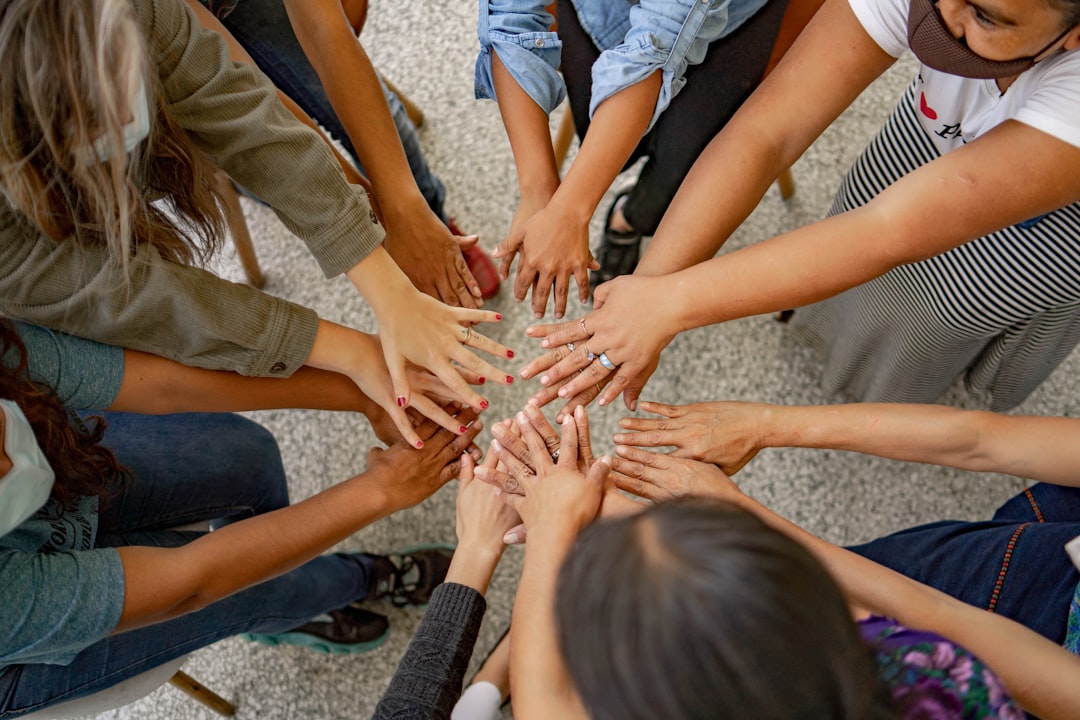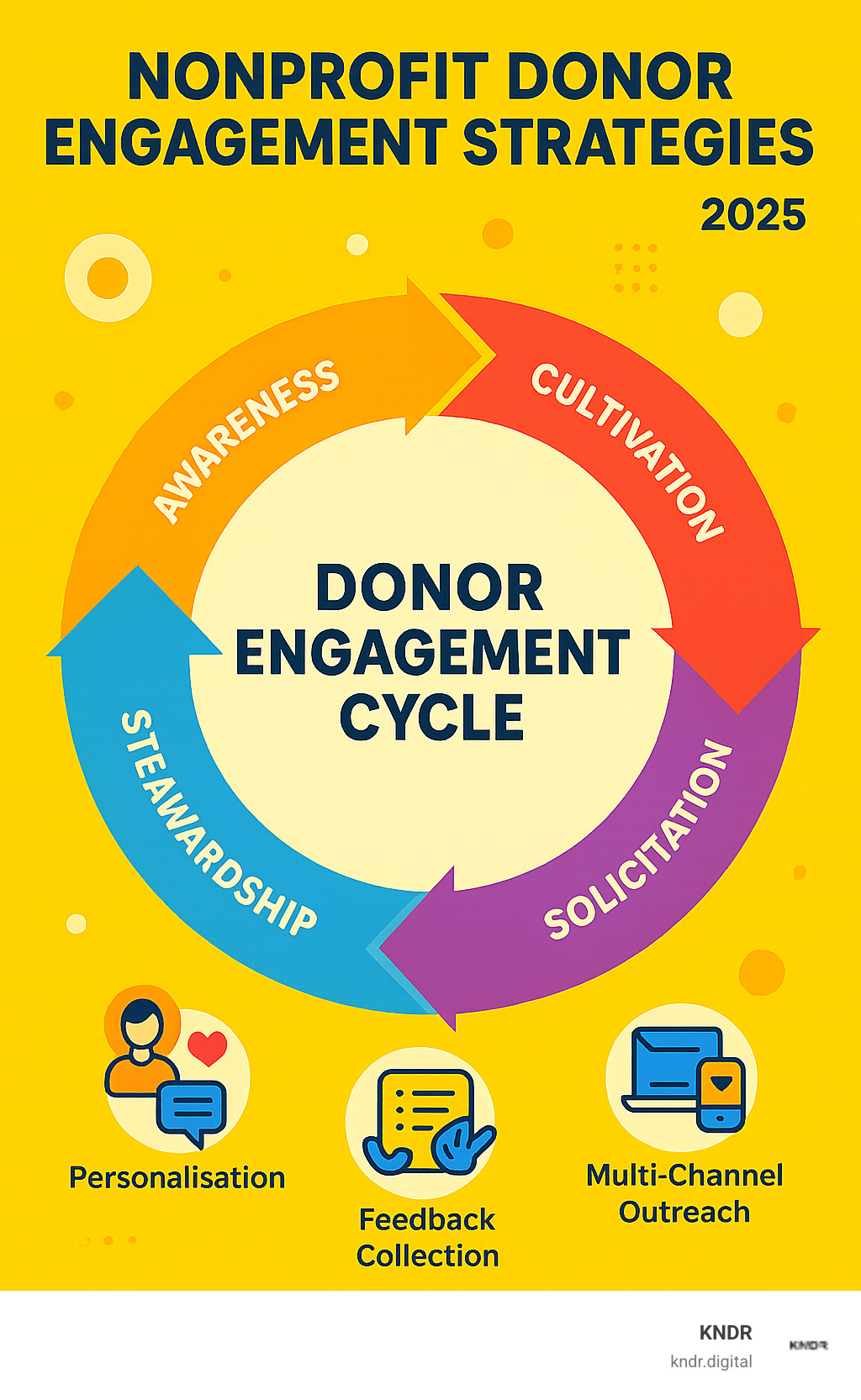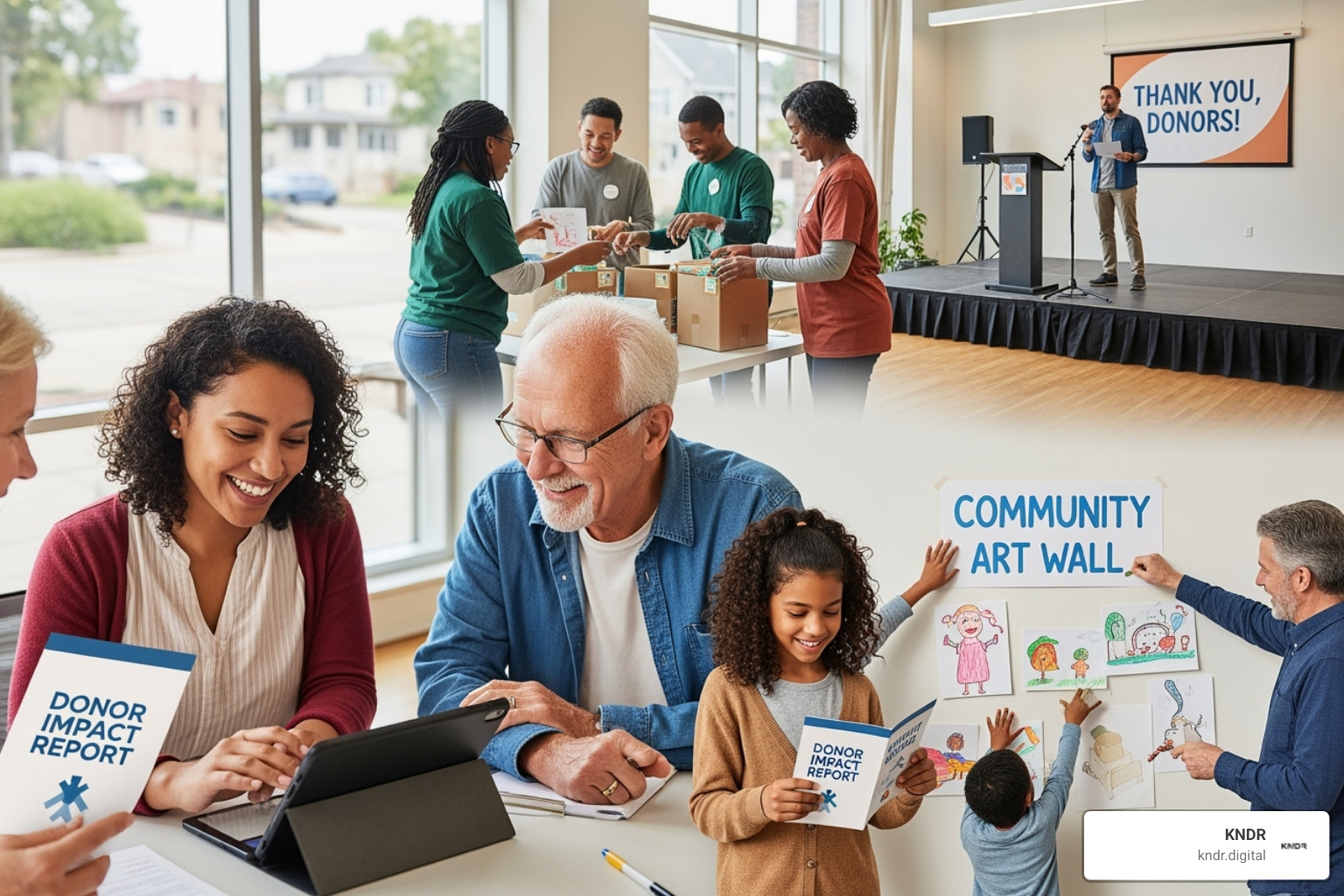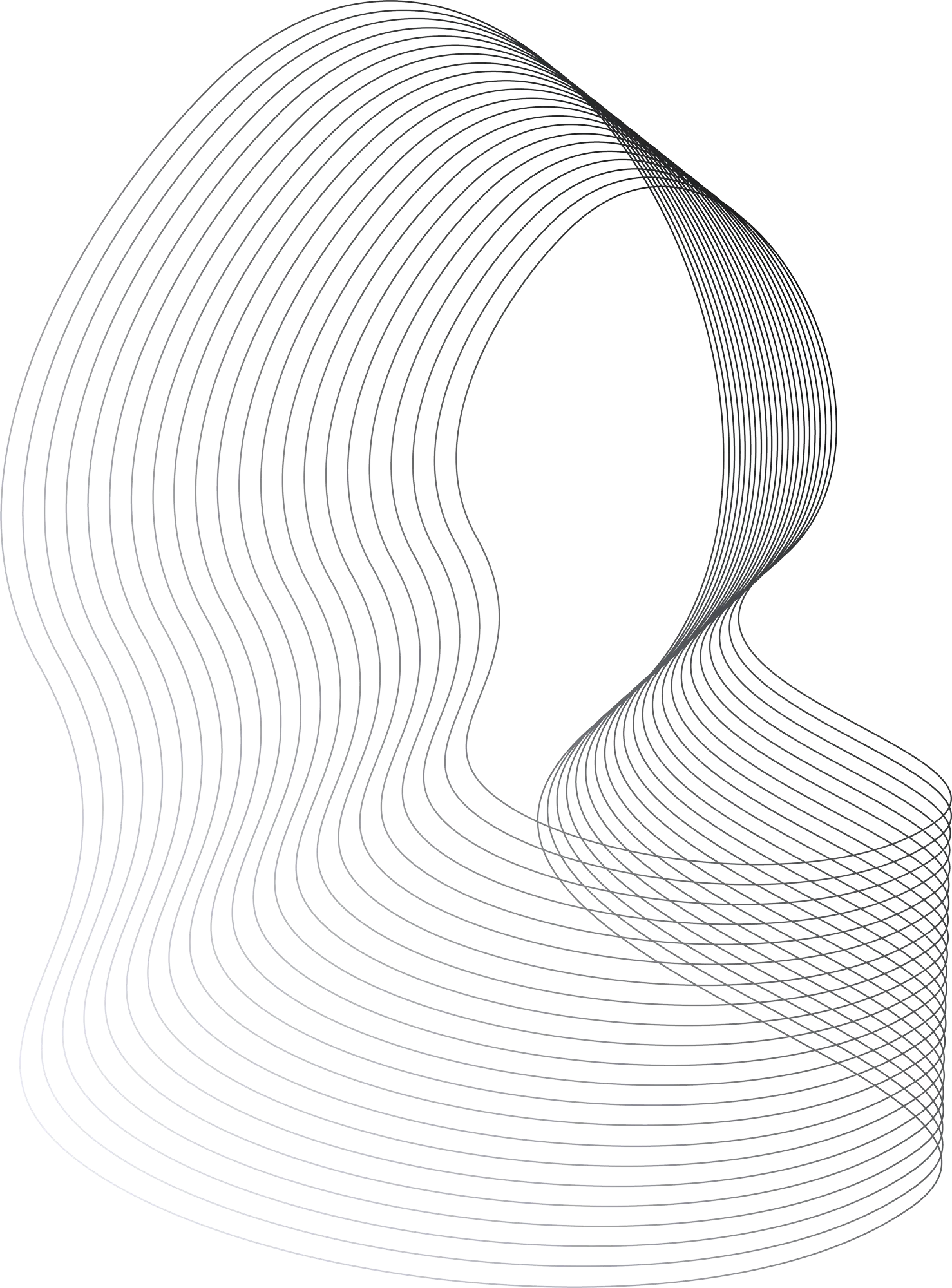Beyond the Ask: Master Donor Engagement for Lasting Impact

Why Donor Engagement is the Key to Nonprofit Success
Nonprofit donor engagement strategies are the foundation of sustainable fundraising, changing one-time givers into lifelong supporters. While many nonprofits focus on the ask, true success comes from building meaningful relationships that extend far beyond a single donation.
Effective donor engagement includes:
- Personalized communication that references a donor's specific history
- Impact storytelling that shows how contributions create change
- Multi-channel outreach combining digital tools with personal touches
- Volunteer opportunities that deepen a donor's connection to your mission
- Consistent stewardship following the Ask-Thank-Report-Repeat cycle
The stakes are high. A mere 10% improvement in donor retention can increase lifetime giving by up to 200%. Yet many organizations see retention rates for new donors as low as 23%, often because they treat supporters as transactions rather than partners.
Modern donor engagement recognizes that every interaction shapes the relationship. The solution is moving from transactional asks to relational engagement, treating donors as valued community members whose interests and partnership are essential for continued support.
I'm Mahir Iskender, CEO of KNDR.digital, where I help mission-driven organizations scale through AI-powered marketing and digital fundraising. I've spent a decade guiding nonprofits in developing nonprofit donor engagement strategies that blend human connection with smart technology to drive sustainable growth.

Nonprofit donor engagement strategies terms at a glance:
The Foundation: Understanding True Donor Engagement
True donor engagement is about creating genuine, lasting relationships that go far beyond writing a check. It encompasses every touchpoint, from the thank-you email to the volunteer opportunity. Why does this matter? Because engaged donors become your champions, recurring supporters, and most powerful advocates.
According to The latest Donor Trust Report, nearly 70% of donors need to trust a charity before giving. That trust is built through consistent, authentic engagement that helps donors feel a real connection to the impact they're making.
From Supporter to Partner: The Mindset Shift
The most successful nonprofits have partners, not just donors. This mindset shift changes everything. When you treat donors as partners, you acknowledge their active role in creating change. You celebrate their accomplishments: "Thanks to you, Sarah got clean water" is more powerful than "We provided clean water."
This partnership mentality creates a shared purpose and values all forms of support equally, from volunteering to social media advocacy. This approach naturally shifts your focus from short-term gifts to long-term relationships, where a loyal $50 donor can be more valuable than a one-time $500 donor.
The Cost of Disengagement
The numbers tell a sobering story. Acquiring a new donor costs five to seven times more than retaining an existing one. With new donor retention rates hovering around 23%, three out of four first-time donors never give again. This "leaky bucket" of disengaged supporters makes sustainable growth nearly impossible.
Impersonal communication is a primary cause. Generic "Dear Friend" emails tell donors they don't matter as individuals. Investing in strong nonprofit donor engagement strategies plugs these leaks, boosting retention and creating a stable community of supporters who grow with you.
More on building strong donor relationships can help you dive deeper into these concepts.
The Ultimate Toolkit: 10 Powerful Nonprofit Donor Engagement Strategies
Think of donor engagement as tending a garden; it requires ongoing care to flourish. Nonprofit donor engagement strategies work best when they are part of a thoughtful approach that makes every supporter feel valued and connected to your mission.

Effective donor appreciation often comes from unexpected, personal touches. The most impactful gestures show donors you're thinking of them beyond their wallets and see them as individuals, not just names in a database. Consider these ideas:
- A handwritten thank-you note from someone impacted by their gift.
- Exclusive behind-the-scenes content that makes donors feel like insiders.
- Surprise tokens of appreciation, like a bookmark or a photo from beneficiaries.
- Personal phone calls just to say thanks, with no additional ask.
- Community access through private online groups or special events.
- Milestone acknowledgments for giving anniversaries.
Now let's explore the ten core strategies that transform casual supporters into lifelong partners.
1. Master the Art of Personalization
In a world of generic messages, personalized communication doesn't just cut through the clutter—it makes donors feel seen and valued. This is an essential component of effective nonprofit donor engagement strategies.
True personalization goes beyond using a donor's first name. It's about creating messages that feel uniquely custom to each supporter.
- Reference their gift history. Instead of a generic thank you, try: "Your $100 gift in March helped us provide school supplies to 10 children—and we know how much you care about education." This connects their values to real impact.
- Respect communication preferences. Some donors prefer detailed reports, while others want quick text updates. Pay attention to how they engage and adjust your outreach accordingly.
- Use interest-based content. If someone consistently supports your animal welfare programs, send them stories about animals. This targeted approach shows you're listening.
Good data is the foundation of personalization. Your donor management system (CRM) tracks interactions and preferences, providing the insights needed for individualized outreach. Modern tools like AI-driven personalization techniques can analyze this data to help you scale authentic, one-to-one communication, fostering deeper connections and long-term support.
2. Tell Compelling Impact Stories
Nothing connects donors to your mission like a powerful story. When you show donors exactly how their generosity transforms lives, you move beyond generic updates to share specific, compelling narratives. This is where nonprofit donor engagement strategies truly shine.
The golden rule is to show, don't tell. Instead of saying "we helped people," share a story: "Sarah, a single mother of two, received emergency housing thanks to your support. Today, her children are thriving in school."
Beneficiary testimonials are the heart of impact storytelling, offering an authentic and unfiltered perspective. These stories become even more powerful when combined with data visualization. A simple chart showing improved reading levels, paired with a child's story of finishing their first book, creates both an emotional connection and concrete proof of impact.
Multimedia storytelling, such as a short video, can move donors in ways words alone cannot. These visual stories are also highly shareable, extending your reach. By making every story feel personal and specific, you help donors see themselves as vital partners in your success.
Nonprofit Storytelling Framework From Concept to Conversion
3. Blend Digital and Analog Outreach
In our hyperconnected world, the most effective nonprofit donor engagement strategies combine the efficiency of digital tools with the warmth of personal, analog touches.
Digital channels like email and social media form the backbone of modern outreach. Personalized email campaigns can nurture relationships over time, while social media allows for genuine two-way conversations. The key is to build community, not just broadcast appeals. In fact, sending more non-ask cultivation emails can actually increase revenue by strengthening relationships.
Analog outreach cuts through the digital clutter. A handwritten thank-you note or a brief, heartfelt thank-you call (with no ask) creates a memorable, emotional connection that an email can't replicate.
Face-to-face interactions remain the gold standard. Research shows in-person requests are significantly more effective than email. Whether it's a coffee meeting or an invitation to see your programs in action, direct connection builds the strongest bonds.
The secret is to blend these approaches thoughtfully. A new donor might get a welcome email series followed by a handwritten note. By combining digital efficiency with analog warmth, you create relationships that feel both professional and deeply personal.
4. Listen and Respond to Donor Feedback
Effective nonprofit donor engagement strategies require genuine two-way conversations, not one-sided monologues. Actively seeking out donor feedback is not just polite—it's a powerful way to refine your approach and build trust.

When you send out donor surveys, you're saying, "Your voice matters." These surveys help you understand what drives giving, satisfaction levels, and communication preferences. Keep them concise—5-12 questions that take under 5 minutes to complete can provide rich, actionable insights.
However, the worst thing you can do is collect input and ignore it. Closing the feedback loop is critical. Thank donors for their time and, whenever possible, show them how their suggestions led to real improvements. This follow-through transforms a simple survey into a trust-building exercise, proving that you view them as true partners whose opinions shape your work.
How to use donor surveys effectively
5. Turn Donors into Advocates and Volunteers
Your most passionate donors often want to do more than just write a check. Smart nonprofit donor engagement strategies create meaningful ways for supporters to deepen their involvement and become true champions for your cause.
Volunteer opportunities are engagement gold. When donors volunteer, they see your mission in action and feel the impact firsthand. The data confirms this: 85% of volunteers also donate to the nonprofits they serve. This hands-on experience creates a powerful emotional connection.
Peer-to-peer fundraising empowers your supporters to become fundraisers themselves, leveraging their personal networks. A request from a friend is far more powerful than a cold email from an organization.
Your most engaged supporters can also become brand ambassadors, spreading your message authentically within their communities. Equip them with talking points and shareable content to help them succeed. Don't forget your board members, who should be your ultimate advocates, leveraging their networks and making personal outreach calls.
By offering diverse avenues for involvement—from volunteering to social sharing—you build a vibrant community where everyone can contribute in a way that feels meaningful to them.
6. Nurture First-Time Donors into Lifelong Supporters
A first donation is the beginning of a relationship, not the end. Converting first-time donors into recurring givers is one of the most powerful nonprofit donor engagement strategies available. Recurring donors have a significantly higher lifetime value, providing the stable, predictable funding that fuels long-term impact.
After a first gift, a donor is wondering: Did my money help? Does this organization remember me? Your follow-up in the first few weeks is critical.
The magic happens in the first few touchpoints. A prompt, personalized thank-you within 48 hours sets the right tone. Follow this with a thoughtful welcome series that introduces them to your mission without immediately asking for another donation. This could include:
- A heartfelt message from your executive director.
- A short video showing their donation at work.
- An early impact report demonstrating that their gift is already making a difference.
Also, provide immediate opportunities for deeper, non-monetary involvement, like an invitation to a virtual tour or a request for feedback. By creating a clear path for new donors to feel connected and see their impact, you dramatically increase the odds they'll become loyal, recurring supporters.
7. Practice Radical Transparency
Trust is the currency of the nonprofit world. Donors place their faith in our ability to use their contributions wisely, which is why radical transparency is one of the most essential nonprofit donor engagement strategies.
From a donor's perspective, they want to know their hard-earned money is making a real difference. Transparency gives them that confidence.
- Publish detailed annual reports. Create clear, engaging reports that tell the story of your shared accomplishments, not just dry financial statements.
- Share impact metrics regularly. Use simple charts and infographics to show donors throughout the year how their contributions are being used.
- Be open about data usage. Explain how you collect, store, and protect donor information to build trust in your digital practices.
- Secure accreditations. Third-party validations from evaluators like Charity Navigator or GuideStar demonstrate your commitment to best practices and give donors confidence.
Radical transparency creates a positive cycle. When donors see how responsibly you handle their gifts, they feel more confident giving again and become powerful advocates for your work.
8. Make Giving Effortless
In a world of one-click convenience, donors expect a simple and seamless donation process. A clunky or confusing experience can cause you to lose supporters at the final step. Creating an effortless giving process is one of the most practical nonprofit donor engagement strategies you can implement.
Your donation experience should be smooth and intuitive. This means:
- A prominent "Donate" button that's easy to find on your website.
- A mobile-friendly donation form, as more than half of donors now give on mobile devices.
- Minimal required fields. Only ask for the essentials: name, email, donation amount, and payment information. Every extra field increases the risk of abandonment.
- Modern payment options. Offer alternatives like PayPal, Apple Pay, and Google Pay alongside traditional credit card processing to accommodate donor preferences.
A streamlined checkout process with fewer clicks and clear progress indicators creates a positive experience. When giving feels good and is easy to do, it encourages both first-time gifts and recurring donations.
9. Implement a Robust Recognition System
Lack of acknowledgment is the second most common reason donors stop giving. A robust recognition system is an essential nonprofit donor engagement strategy because it ensures every supporter feels genuinely appreciated, reinforcing their decision to give.
Think of recognition as the fuel for the donor relationship. It's about acknowledging the choice a donor made to support your cause.
- Use tiered appreciation. Every donor deserves a heartfelt thank-you, but larger gifts might warrant a personal call from a board member or a special invitation.
- Offer public recognition (with permission). Some donors love seeing their names in newsletters, while others prefer to remain anonymous. Always ask first.
- Add personalized touches. A handmade card from a beneficiary, a custom digital badge, or a short video message from your team can create a lasting emotional connection.
- Celebrate milestones. Acknowledging a donor's giving anniversary shows you're paying attention to the relationship, not just the transaction.
Consistency is key. When you consistently and creatively show gratitude, you build a foundation for a lasting partnership that benefits everyone.
10. Provide Consistent Value Beyond the Donation
Good relationships aren't transactional. The best nonprofit donor engagement strategies involve consistently providing value that goes beyond the donation ask. This approach keeps your mission top-of-mind and transforms your communications from a solicitation to a welcome update.
When donors look forward to hearing from you, you've won. You can achieve this by becoming a trusted resource and a source of inspiration.
- Share educational content. Offer insights, research, or practical tips related to your cause. An environmental group might share tips on sustainable living, making you a helpful resource.
- Provide behind-the-scenes glimpses. Introduce team members, share a "day in the life," or give updates on ongoing projects. This transparency builds trust and makes your work feel tangible.
- Host non-ask events. Donor appreciation parties, facility tours, or educational webinars focused purely on connection show donors you value them as people, not just as funders.
By consistently offering valuable content and experiences, you nurture relationships that transcend transactions. Your donors feel informed, connected, and appreciated, making them far more likely to give generously when you do make an ask.
The Engine Room: Technology and Metrics for Engagement
Technology is the backstage crew for your donor engagement efforts, powering the personalized experiences that make supporters feel connected. To scale authentic relationships, you need smart systems to make data-driven decisions that strengthen your mission.

Leveraging Technology: From CRM to AI
Your donor management software (CRM) is your relationship headquarters, providing a complete picture of each donor. Marketing automation builds on this, allowing you to send personalized welcome series or updates based on donor actions. AI-driven fundraising tools amplify the human touch, not replace it. These systems can identify donors who might be ready for a larger gift or are at risk of lapsing, helping you focus your personal attention where it matters most.
AI-Driven Fundraising toolsHow to Automate Marketing for Nonprofits
Key Metrics to Track for Your Nonprofit Donor Engagement Strategies
If you're not measuring your efforts, you're flying blind. Track these key metrics to understand what's working:
- Donor retention rate: The percentage of donors who give year after year. This is your north star.
- Lifetime value (LTV): The total revenue a donor brings over their lifetime. This reveals the true impact of engagement.
- Email open/click-through rates: A direct measure of how well your content is resonating.
- Social media interactions: Likes, shares, and comments show community engagement beyond donations.
- First-time vs. repeat donor ratio: Indicates if you're building sustainable relationships.
Overview of KNDR's Analytics Solutions
Putting It All Together: Building Your Donor Engagement Plan
A comprehensive donor engagement plan moves your fundraising from reactive to proactive and relationship-driven. A good plan is structured and goal-oriented, using SMART goals (Specific, Measurable, Achievable, Relevant, Time-bound) to create clear targets and a roadmap for achieving them.
The Donor Engagement Cycle: Ask, Thank, Report, Repeat
At the heart of any strong plan is the continuous donor engagement cycle: Ask, Thank, Report, Repeat. This framework ensures you're nurturing relationships at every stage. It begins with cultivation (building trust before the ask), moves to solicitation (the ask itself), and then focuses heavily on stewardship (thanking donors, reporting on impact, and repeating the cycle). This continuous loop ensures donors always feel valued, informed, and connected.
More on effective Charity Campaign Strategy
The Power of Segmentation for Targeted Nonprofit Donor Engagement Strategies
One size does not fit all. Segmentation is a cornerstone of effective nonprofit donor engagement strategies because it allows you to tailor outreach to diverse donor groups. By dividing your database into meaningful segments, you can create more personal and relevant communications. Common segments include:
- Giving level: Major, mid-level, and small-dollar donors.
- Donor status: First-time, recurring, and lapsed donors.
- Interests: Donors passionate about a specific program.
- Communication preferences: Email, direct mail, phone calls, etc.
Segmentation ensures your messages are relevant and timely, leading to stronger relationships and increased support.
The Complete Guide to AI-Powered Donor Segmentation
Frequently Asked Questions about Donor Engagement
Certain questions about nonprofit donor engagement strategies come up again and again. Here are concise answers to the three we hear most often.
What is the difference between donor engagement and donor stewardship?
Think of it like gardening. Donor engagement is the entire process: preparing the soil, planting, watering, and harvesting. It covers every single touchpoint between your organization and a supporter.
Donor stewardship is a crucial part of engagement. It's what happens after a gift is made—the watering and care. It includes thank-yous, impact reports, and recognition that cultivate the relationship for the next gift. Stewardship is a phase within the larger strategy of engagement.
How often should I communicate with my donors?
Consistency beats frequency. Aim for a regular, predictable rhythm, like a monthly newsletter. The key is that most of your communications should not be asks. Focus on providing value through impact stories, behind-the-scenes updates, and educational content. If your unsubscribe or open rates change dramatically, your data is telling you to adjust your frequency.
What's the single most effective donor engagement tactic for a small nonprofit?
If you have limited resources, focus on genuine, personal appreciation combined with clear impact reporting. This doesn't require fancy technology. Spend time each week making personal thank-you calls (with no ask) or writing handwritten notes. Then, follow up by showing donors exactly what their specific gift accomplished (e.g., "Your $50 provided school supplies for two children"). This combination of authentic gratitude and tangible impact builds powerful, lasting connections.
Conclusion: Build Deeper Connections, Drive Greater Impact
Effective nonprofit donor engagement strategies are about building a community, not just raising money. When donors feel truly connected to your cause, they become loyal champions who give, volunteer, and advocate for your mission.
The strategies we've covered—from personalization and storytelling to transparency and recognition—all work together to build authentic, lasting relationships. Today, technology makes it easier than ever to scale these connections. AI and automation don't replace the human touch; they amplify it, allowing you to send personalized messages and timely reminders that strengthen bonds.
At KNDR, we've seen how AI-driven systems can boost donations and donor engagement. Our holistic digital strategies help nonprofits streamline the technical work so you can focus on what you do best: building relationships and changing lives.
Donors today expect genuine appreciation and real impact. When you treat them as partners, they respond with incredible loyalty. You're not just building a donor base—you're building a movement.


